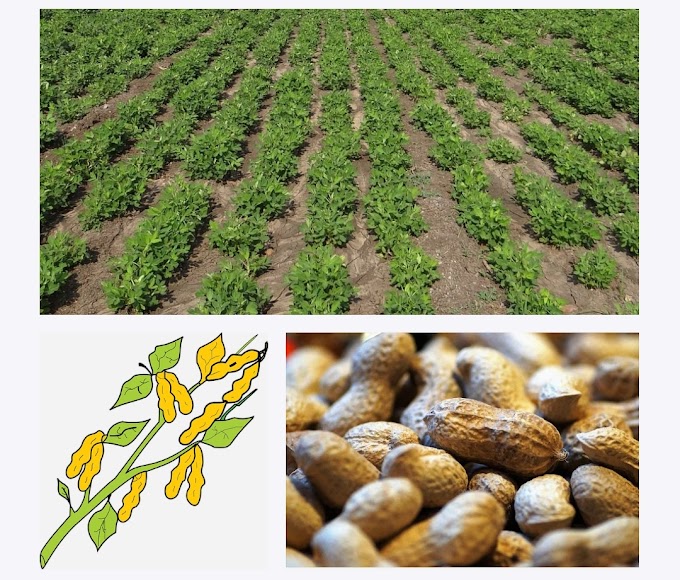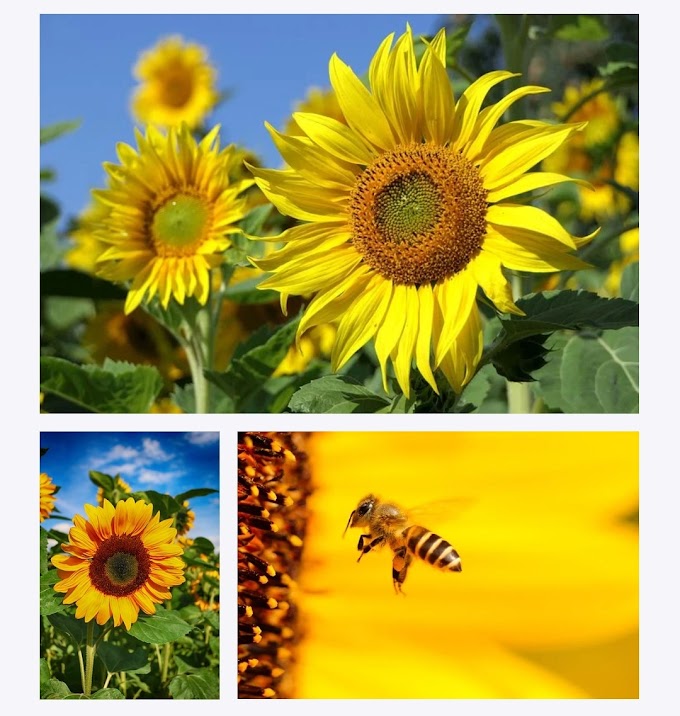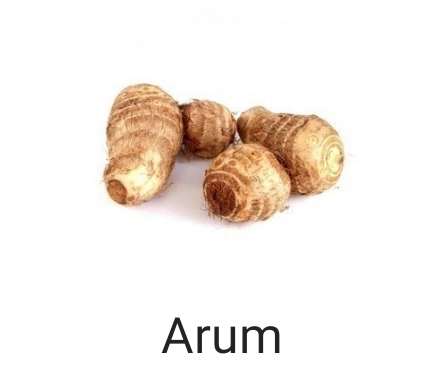 |
| Groundnuts Cultivation |
Field tillage and soil preparation for the Groundnut Farming and Cultivation
Good drainage, brittle loam and sandy loam land are the best for groundnut cultivation.
After the first tillage of the soil, 3-4 tillage from the native plough, or the last time after the hair or the cultivator, the dung manure should be mixed into 5 tonnes per acre of soil at the time of ploughing the field.
Land Treatment:-
Land treatment for prevention of underground pests and termites, land treatment is necessary before sowing. Where there is a special outbreak of white braid, the recommendation for prevention of white braid should be adopted. Termites will be controlled by the same pesticides. In areas where there is only termite outbreak, 1.5 per cent powder should be added before sowing in land at the rate of 10 kg per acre to prevent termites.
In the absence of easy cleaning of the field, such as dry stalks, etc., to reduce the outbreak of termites, it is very helpful to remove the raw manure, etc. White braided control is an outbreak of white braided in most kharif crops. Its adult state (beetle) and braid cause both damage.
Adult insect (beetle control) heavy rains on or before monsoon and water in the fields of some areas begin to get out of the ground. The beetles go out of the ground at night and sit on the host trees. The host trees are mostly kheherb, plum, neem, guava and mango etc.
The exit of the beetle lasts for 4 to 5 days. On the host trees in the areas affected by white braiding, the beetles rest at night. Spray such trees in the same trees by sorting them at night and on the second day monocrotophos 36 sl 25 ml or culofas 25 EC36 ml per 15 litres of water. Three days after the roast starts laying eggs, spraying is beneficial immediately.
Where the adult beetle has the facility to catch the host trees at night, after the exit of the beetles, at about 9 o'clock in the night, shake down the beetles sitting on the host trees with the help of bamboo and destroy the kerosene water (one part of kerosene and 20 parts of water).
Control in a state with lats -
Cunalphos 5 percent particle or carbofuron 3 percent particle or sevimol 4 percent particle at the rate of 25 kg per hectare.
Four litre chlorpyriphos 20 EC for white braided control in standing crop Should be accompanied by irrigation water at the rate of per hectare.
Do this treatment in a standing crop with a large number of beetles/around 21 days of monsoon rainfall.
Termite control by allied fungus -
Add 10 kg of friend fungus Bavaria bassiana or metariium ansopoli powder to the pre-sowing field by culture in 125 kg of dung manure at the rate of per hectare.
seeding method
Groundnut is peeled and sown in flat land. It is an unscientific method. The plant number is inadequate and there is difficulty in weeding the crop. The yield is also very low. The following methods should often be used for sowing of groundnut:
(i) Sowing in the dustbins behind the plough -
Sowing of seeds from behind the native plough 5-7 cm in the dustbins. is done at depth.
 |
| Groundnuts Cultivation |
(ii) Dibler Method:
This method is suitable for sowing in a small area. The rows form holes with the help of scrape, which add seeds and cover them with soil. It reduces the amount of seed. It takes more labour and expenditure.
(ii) Seed Planter -
Sowing from this device takes place in a shorter time in a higher area. After sowing the seed, the seed is covered by running the pata. The depth of the seed according to the type of land and the amount of moisture is 5-7 cm. should be kept between. This method saves labour and expenditure.
Seed Varieties
Advanced Varieties:-
There are three different species of peanuts. For light soil spread and heavy soil, there are species of jhumka variety plants, which are used to sow according to the land.
The branches of plants of low-spreading or spreading species spread and peanuts are far away. While the legumes of the Jhumka species are near the main root and the grain is pink or red in colour. Its yields are less than the spreading species, but it is quickly cooked. The details of the characteristics of suitable varieties are as follows:
HNG 10:-
It is suitable for semi-expanding variety, good rainfall or areas where life saving irrigation is water availability. Its leaves are deep green and the plants are moderately dispersed.
This variety yields about 10 quintals per acre in 125-130 days. Its pods have an average of two grains. The weight of 100 grains is about 45 grams and the amount of oil is 50-51%.
TG37A:-
Is a tuctored, medium height and straight growing variety that yields about 10 quintals per acre in 120-125 days. Its grains are pink in colour and 100 grains weigh 48 grams. They have a quantity of 48% oil and 23% protein.
G-20:-
It is a semi-expanding variety that is cooked in 115 to 120 days, with 2 to 3 grains generally in its pods. 100 grains weigh about 42 grams and 48% oil in grains. The average yield is 12 to 14 quintals/acre.
TG39:-
This clustered variety was jointly developed by Bhabha Molecule Research Centre, Mumbai and Rajasthan Agricultural University, Bikaner. The grains are large and the variety is cooked in about 115-120 days. It also reduces stem melting and pelia disease. The average yield is 12-15 quintals per acre.
Girnar-2 :-
This variety developed by Directorate of Groundnut Research, Junagadh (Gujarat) is mainly suitable for kharif season. This type of grain is large in size and a weight of about 62 grams of hundred grains. The average yield is up to 14 quintals per acre. The quantity of oil in its grains is stated to be 51%. This variety is described as tolerant to rust disease.
HNG 123 :-
This variety developed by The Agricultural Research Sub-Centre Hanumangarh is of a bunchlike type. The average yield of this variety is 15 quintals per acre and the quantity of oil in grains is 49%.
RG 425:-
This variety developed by Rajasthan Agricultural Research Institute Durgapura has been disposed of for kharif season especially for the state of Rajasthan. The average yield of this variety is 12-16 quintals per acre and the quantity of oil in grains is 48%. This variety is described as resistant to drought and collar melting disease.
RG 510:-
Virgins This type of class is of the expanding class. Its grain is coarse and 100 dano weighs about 65-68 grams, averaging 14 to 15 quintals per acre. This variety is resistant to diseases like colarrot stemrot leaf spots etc. And is also tolerant of insects such as thrips, jassid and grasshopper.
Chandra, T.B.G.-39, A.M.-13 and Mallika.
Fertilizer Information
- The land should have a proper quantity of nutrients to take good and quality crop of groundnut. The quantity of fertilizers should be decided on the basis of soil test result.
- Recommended with compost manure for proper nutritional management in groundnut. Use the ratio of fertilizers to NPK 10:20:10 kg per acre.
Natrijan:-
Mix 10 kg of urea per acre at the time of sowing and pour 12 kg of urea into a steep crop after 30 to 35 days after sowing.
125 kg SSP per acre sowing phosphorus:-
Time mix the entire quantity in the field.
Potas:-
17 kg mureat of potas (mop) at the time of sowing per acre, mix the entire quantity in the field. Potash is needed for good development of roots.
Gypsum:-
80 kg at the time of sowing and 45 days after sowing in steep crop, 80 gypsum fields!
Diseases & Treatment
(i) Peanut leaf chiti or tikka disease First,
The symptoms of the disease appear as light spots on the upper surface of the leaves, and the lower outer skin of the leaf begins to end, these spots are spherical to irregular in shape and yellow stead around them. Initially, it is lower by a yellow circle and the lower surface of these spots is black. Legumes are very low and small from diseased plants. To control this disease, seeds should be treated by thyram or captan and grow inter-crop of jowar or bajra with groundnut crop to reduce the outbreak. On the crop should spray carbendajim 0.1% or mencozeb 0.2%.
(ii) Root rot disease:
With the effect of this disease, the plants begin to fall yellow, the stem part of the plant adjoining the surface of the soil starts drying. The roots show a white formation like spider webs. In the affected pods, the grains are shrunk or completely rotten, the peel of the pods also rots. To control this disease, the seed should be treated and sown and the summer should be deeply ploughed. Adopt a long-term crop cycle. Seed fungal drugs such as thyrum or carbendajim 3 grams of medicine should be used at the rate of seed per kg.
Auxiliary Machines
Soil overturned plough, native plough, hers, khurpi, hoe, shovel, etc. are required.
Weed Control
About 15-20 days after the sowing of groundnut, the first day-to-day and 30-35 days should be followed by the second.
Health & Nutritional Quality
It also has a variety of health-related properties such as iron, niacin, folate, calcium and zinc. With all these features, it is a good and inexpensive source of vegetable proteins.
















1 Comments
How to Make Money From Betting on Horse Racing - Work
ReplyDeleteIn this article, we will febcasino show you some basic tips on how หารายได้เสริม to win money from betting on horse racing. In this 메리트카지노 article, we will show you some basic